Detailed Case Study: Burwell v. Hobby Lobby Stores, Inc. - Law
VerifiedAdded on 2022/12/01
|9
|1992
|1
Case Study
AI Summary
This case study analyzes Burwell, Secretary of Health and Human Services, et al. v. Hobby Lobby Stores, Inc., a pivotal Supreme Court case concerning the Religious Freedom Restoration Act (RFRA) and the Affordable Care Act's (ACA) contraception mandate. The core issue revolves around whether for-profit corporations can be exempt from the ACA's requirement to provide contraceptive coverage to female employees if it violates the owners' religious beliefs. The case examines the application of RFRA, the definition of 'person' under the law, and the balance between religious freedom and public health. The case study explores the arguments of both the majority and dissenting opinions, including the interpretation of the First Amendment's Free Exercise Clause and the distinction between for-profit and non-profit organizations. The Supreme Court ultimately ruled in favor of Hobby Lobby, holding that the contraception mandate substantially burdened the company's religious freedom, providing a significant precedent regarding religious exemptions for corporations.
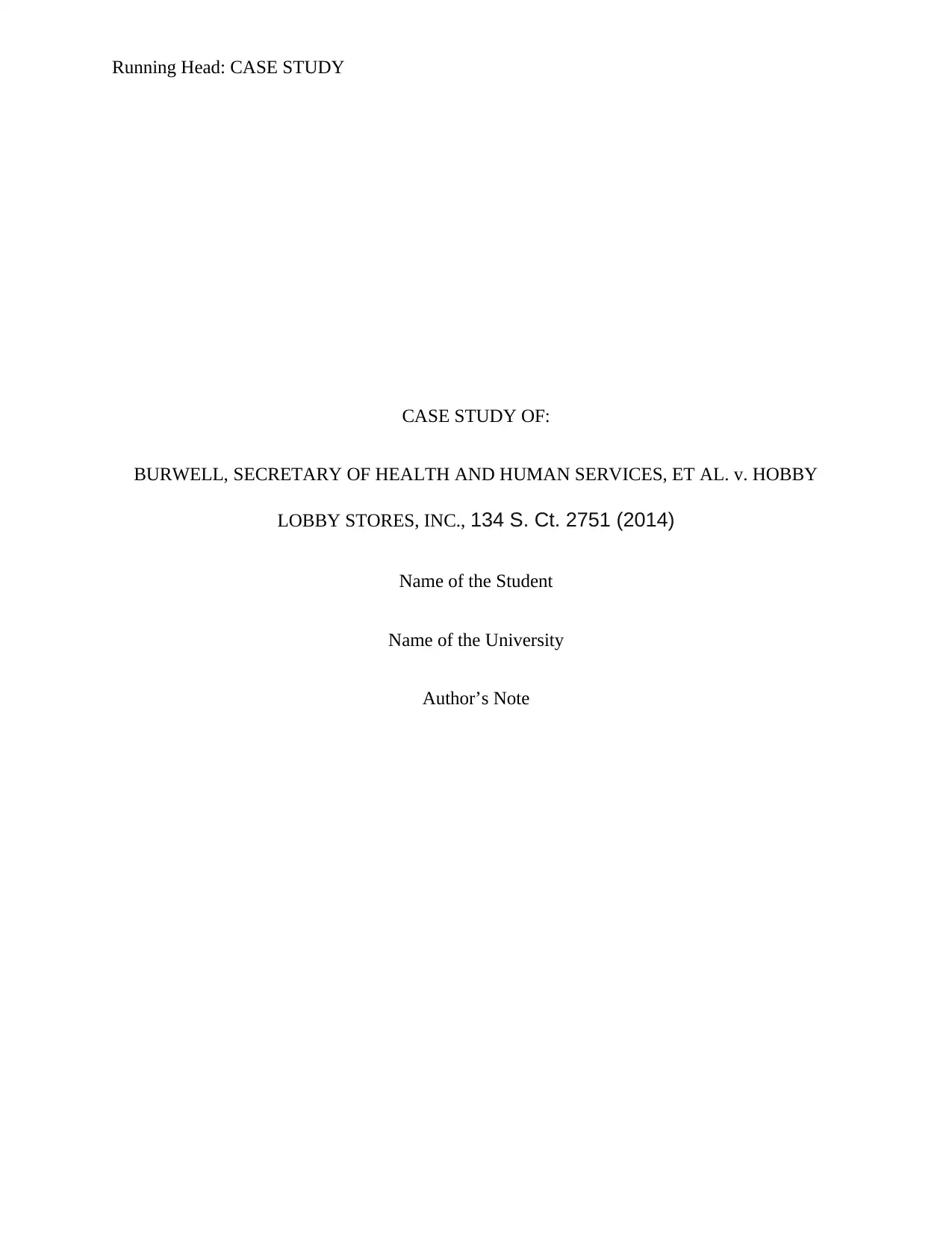
Running Head: CASE STUDY
CASE STUDY OF:
BURWELL, SECRETARY OF HEALTH AND HUMAN SERVICES, ET AL. v. HOBBY
LOBBY STORES, INC., 134 S. Ct. 2751 (2014)
Name of the Student
Name of the University
Author’s Note
CASE STUDY OF:
BURWELL, SECRETARY OF HEALTH AND HUMAN SERVICES, ET AL. v. HOBBY
LOBBY STORES, INC., 134 S. Ct. 2751 (2014)
Name of the Student
Name of the University
Author’s Note
Paraphrase This Document
Need a fresh take? Get an instant paraphrase of this document with our AI Paraphraser
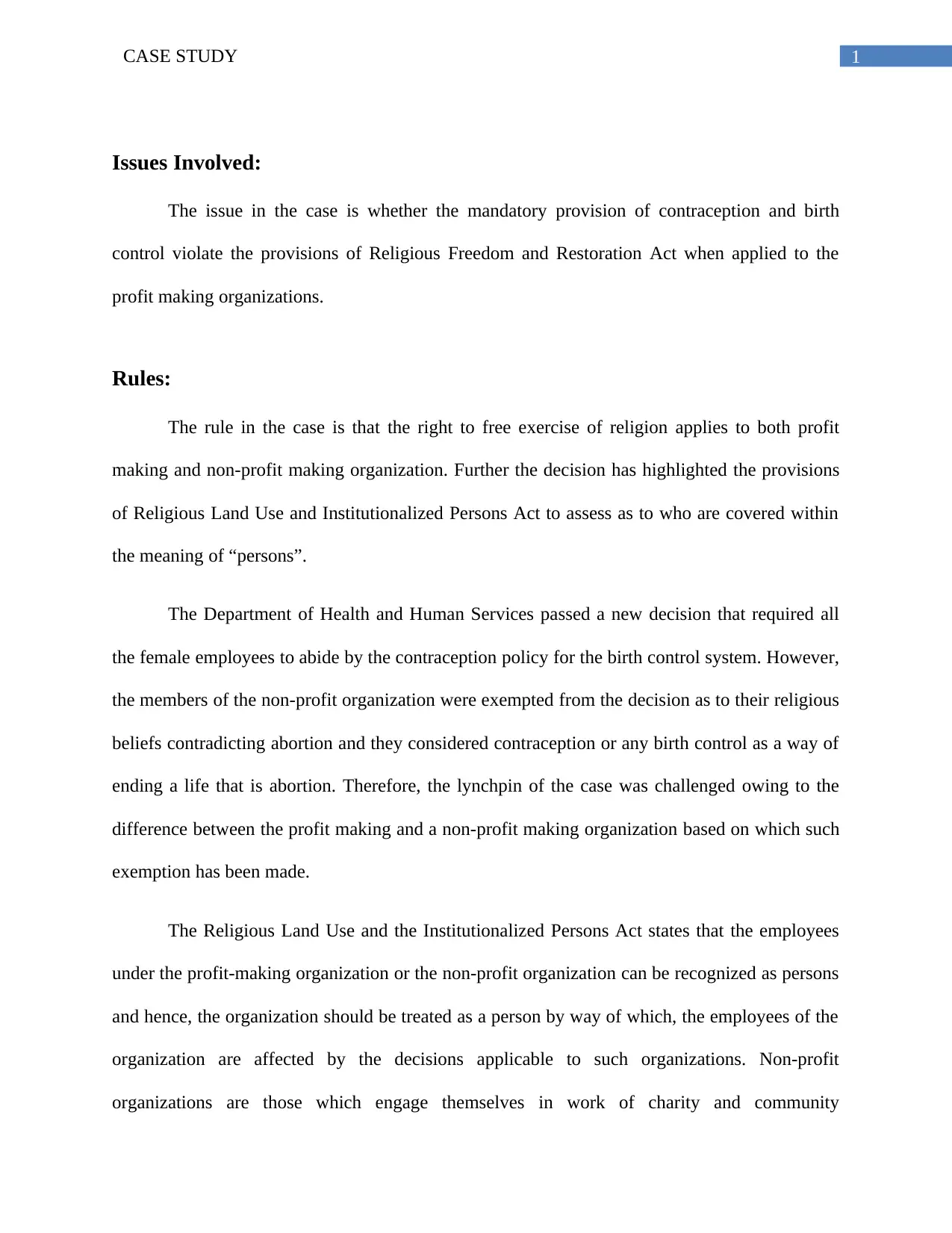
1CASE STUDY
Issues Involved:
The issue in the case is whether the mandatory provision of contraception and birth
control violate the provisions of Religious Freedom and Restoration Act when applied to the
profit making organizations.
Rules:
The rule in the case is that the right to free exercise of religion applies to both profit
making and non-profit making organization. Further the decision has highlighted the provisions
of Religious Land Use and Institutionalized Persons Act to assess as to who are covered within
the meaning of “persons”.
The Department of Health and Human Services passed a new decision that required all
the female employees to abide by the contraception policy for the birth control system. However,
the members of the non-profit organization were exempted from the decision as to their religious
beliefs contradicting abortion and they considered contraception or any birth control as a way of
ending a life that is abortion. Therefore, the lynchpin of the case was challenged owing to the
difference between the profit making and a non-profit making organization based on which such
exemption has been made.
The Religious Land Use and the Institutionalized Persons Act states that the employees
under the profit-making organization or the non-profit organization can be recognized as persons
and hence, the organization should be treated as a person by way of which, the employees of the
organization are affected by the decisions applicable to such organizations. Non-profit
organizations are those which engage themselves in work of charity and community
Issues Involved:
The issue in the case is whether the mandatory provision of contraception and birth
control violate the provisions of Religious Freedom and Restoration Act when applied to the
profit making organizations.
Rules:
The rule in the case is that the right to free exercise of religion applies to both profit
making and non-profit making organization. Further the decision has highlighted the provisions
of Religious Land Use and Institutionalized Persons Act to assess as to who are covered within
the meaning of “persons”.
The Department of Health and Human Services passed a new decision that required all
the female employees to abide by the contraception policy for the birth control system. However,
the members of the non-profit organization were exempted from the decision as to their religious
beliefs contradicting abortion and they considered contraception or any birth control as a way of
ending a life that is abortion. Therefore, the lynchpin of the case was challenged owing to the
difference between the profit making and a non-profit making organization based on which such
exemption has been made.
The Religious Land Use and the Institutionalized Persons Act states that the employees
under the profit-making organization or the non-profit organization can be recognized as persons
and hence, the organization should be treated as a person by way of which, the employees of the
organization are affected by the decisions applicable to such organizations. Non-profit
organizations are those which engage themselves in work of charity and community
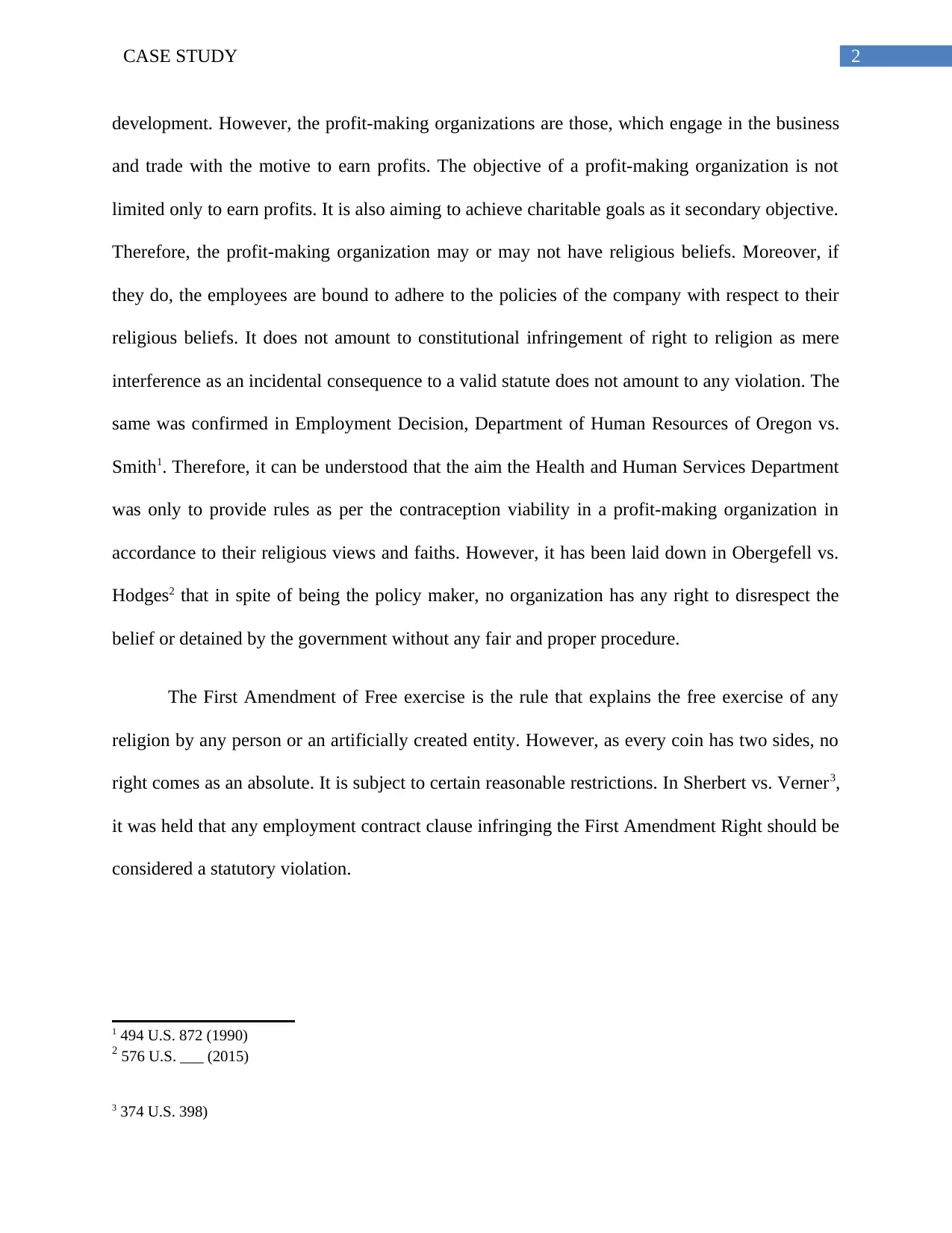
2CASE STUDY
development. However, the profit-making organizations are those, which engage in the business
and trade with the motive to earn profits. The objective of a profit-making organization is not
limited only to earn profits. It is also aiming to achieve charitable goals as it secondary objective.
Therefore, the profit-making organization may or may not have religious beliefs. Moreover, if
they do, the employees are bound to adhere to the policies of the company with respect to their
religious beliefs. It does not amount to constitutional infringement of right to religion as mere
interference as an incidental consequence to a valid statute does not amount to any violation. The
same was confirmed in Employment Decision, Department of Human Resources of Oregon vs.
Smith1. Therefore, it can be understood that the aim the Health and Human Services Department
was only to provide rules as per the contraception viability in a profit-making organization in
accordance to their religious views and faiths. However, it has been laid down in Obergefell vs.
Hodges2 that in spite of being the policy maker, no organization has any right to disrespect the
belief or detained by the government without any fair and proper procedure.
The First Amendment of Free exercise is the rule that explains the free exercise of any
religion by any person or an artificially created entity. However, as every coin has two sides, no
right comes as an absolute. It is subject to certain reasonable restrictions. In Sherbert vs. Verner3,
it was held that any employment contract clause infringing the First Amendment Right should be
considered a statutory violation.
1 494 U.S. 872 (1990)
2 576 U.S. ___ (2015)
3 374 U.S. 398)
development. However, the profit-making organizations are those, which engage in the business
and trade with the motive to earn profits. The objective of a profit-making organization is not
limited only to earn profits. It is also aiming to achieve charitable goals as it secondary objective.
Therefore, the profit-making organization may or may not have religious beliefs. Moreover, if
they do, the employees are bound to adhere to the policies of the company with respect to their
religious beliefs. It does not amount to constitutional infringement of right to religion as mere
interference as an incidental consequence to a valid statute does not amount to any violation. The
same was confirmed in Employment Decision, Department of Human Resources of Oregon vs.
Smith1. Therefore, it can be understood that the aim the Health and Human Services Department
was only to provide rules as per the contraception viability in a profit-making organization in
accordance to their religious views and faiths. However, it has been laid down in Obergefell vs.
Hodges2 that in spite of being the policy maker, no organization has any right to disrespect the
belief or detained by the government without any fair and proper procedure.
The First Amendment of Free exercise is the rule that explains the free exercise of any
religion by any person or an artificially created entity. However, as every coin has two sides, no
right comes as an absolute. It is subject to certain reasonable restrictions. In Sherbert vs. Verner3,
it was held that any employment contract clause infringing the First Amendment Right should be
considered a statutory violation.
1 494 U.S. 872 (1990)
2 576 U.S. ___ (2015)
3 374 U.S. 398)
⊘ This is a preview!⊘
Do you want full access?
Subscribe today to unlock all pages.

Trusted by 1+ million students worldwide
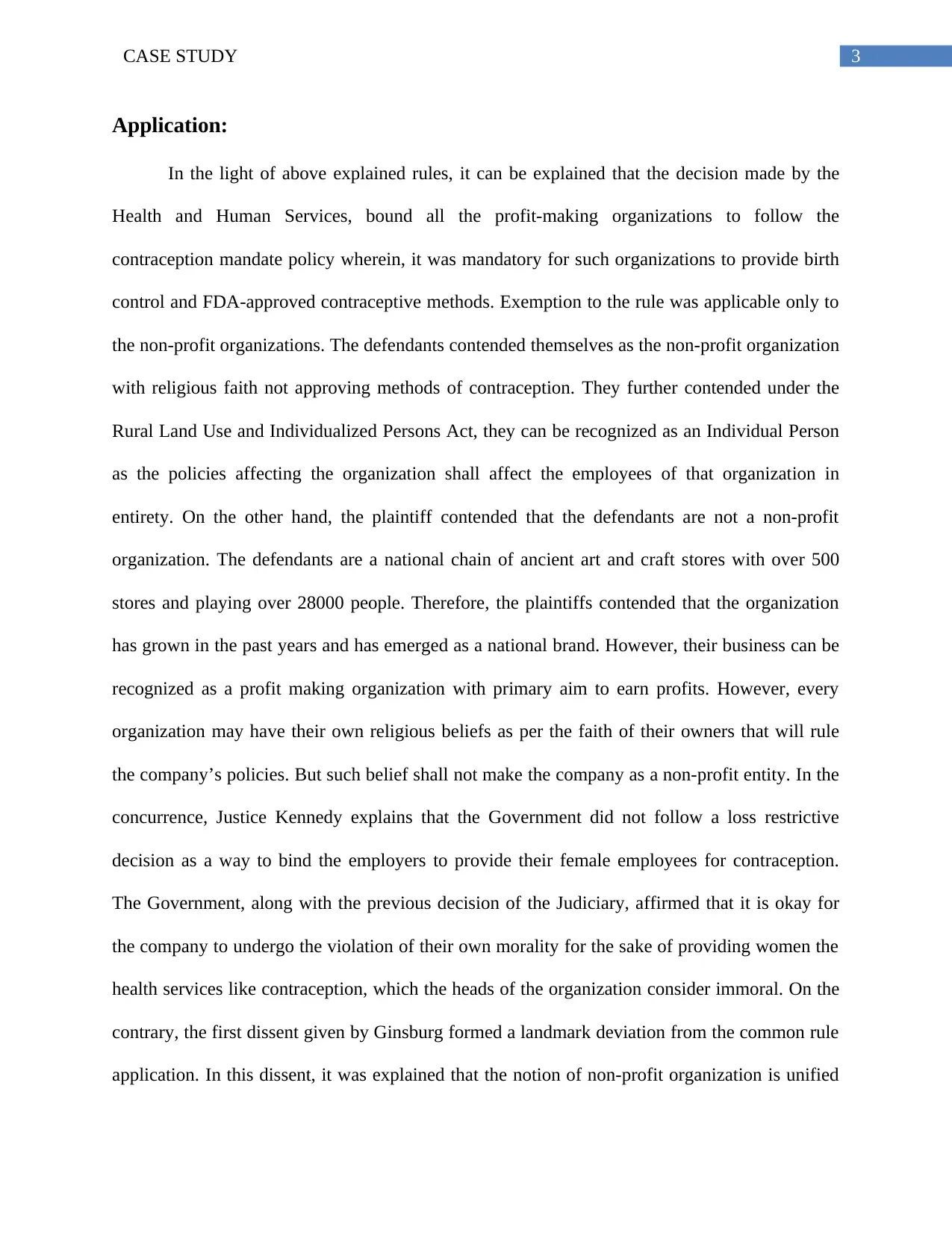
3CASE STUDY
Application:
In the light of above explained rules, it can be explained that the decision made by the
Health and Human Services, bound all the profit-making organizations to follow the
contraception mandate policy wherein, it was mandatory for such organizations to provide birth
control and FDA-approved contraceptive methods. Exemption to the rule was applicable only to
the non-profit organizations. The defendants contended themselves as the non-profit organization
with religious faith not approving methods of contraception. They further contended under the
Rural Land Use and Individualized Persons Act, they can be recognized as an Individual Person
as the policies affecting the organization shall affect the employees of that organization in
entirety. On the other hand, the plaintiff contended that the defendants are not a non-profit
organization. The defendants are a national chain of ancient art and craft stores with over 500
stores and playing over 28000 people. Therefore, the plaintiffs contended that the organization
has grown in the past years and has emerged as a national brand. However, their business can be
recognized as a profit making organization with primary aim to earn profits. However, every
organization may have their own religious beliefs as per the faith of their owners that will rule
the company’s policies. But such belief shall not make the company as a non-profit entity. In the
concurrence, Justice Kennedy explains that the Government did not follow a loss restrictive
decision as a way to bind the employers to provide their female employees for contraception.
The Government, along with the previous decision of the Judiciary, affirmed that it is okay for
the company to undergo the violation of their own morality for the sake of providing women the
health services like contraception, which the heads of the organization consider immoral. On the
contrary, the first dissent given by Ginsburg formed a landmark deviation from the common rule
application. In this dissent, it was explained that the notion of non-profit organization is unified
Application:
In the light of above explained rules, it can be explained that the decision made by the
Health and Human Services, bound all the profit-making organizations to follow the
contraception mandate policy wherein, it was mandatory for such organizations to provide birth
control and FDA-approved contraceptive methods. Exemption to the rule was applicable only to
the non-profit organizations. The defendants contended themselves as the non-profit organization
with religious faith not approving methods of contraception. They further contended under the
Rural Land Use and Individualized Persons Act, they can be recognized as an Individual Person
as the policies affecting the organization shall affect the employees of that organization in
entirety. On the other hand, the plaintiff contended that the defendants are not a non-profit
organization. The defendants are a national chain of ancient art and craft stores with over 500
stores and playing over 28000 people. Therefore, the plaintiffs contended that the organization
has grown in the past years and has emerged as a national brand. However, their business can be
recognized as a profit making organization with primary aim to earn profits. However, every
organization may have their own religious beliefs as per the faith of their owners that will rule
the company’s policies. But such belief shall not make the company as a non-profit entity. In the
concurrence, Justice Kennedy explains that the Government did not follow a loss restrictive
decision as a way to bind the employers to provide their female employees for contraception.
The Government, along with the previous decision of the Judiciary, affirmed that it is okay for
the company to undergo the violation of their own morality for the sake of providing women the
health services like contraception, which the heads of the organization consider immoral. On the
contrary, the first dissent given by Ginsburg formed a landmark deviation from the common rule
application. In this dissent, it was explained that the notion of non-profit organization is unified
Paraphrase This Document
Need a fresh take? Get an instant paraphrase of this document with our AI Paraphraser

4CASE STUDY
by its aim, which is solely based on the religious and customary belief. On the other hand, in the
profit making organization, the aim of the corporation is primarily to make maximum profit and
it achieve that, it employs people from all sphere of communities irrespective of their religious
faiths. The last principle that was brought into the question was the first Amendment of the free
exercise, which explains free exercise of religion by all. In Estate of Thornton vs. Calder4, it was
held that the statute, which provided for all the persons to an absolute right to not work on
Sabbath so as to advance religion was struck down. Therefore, the right to religion is not
absolute in nature. The right comes with reasonable restrictions as laid down by the law. In
Reynolds vs United States5, it was held that the law prohibiting polygamy was applicable even in
cases where the religion allowed it. This was done to recognize the activities, which are
considered unlawful by the law of the land and subsequently punish the offender for the same.
For the first time in Cantwell vs. Connecticut6 was applied to the states wherein the State of
Connecticut was held liable to violate the First Amendment of the free exercise. It was held that
the state and its officials could not determine which solicitations are religious and which are not.
Such determination of religious truth shall violate the right to free exercise of religion. Therefore,
it was stated that the First Amendment Clause applies to government as well as corporate entities
including the profit making organizations.
Breyer & Kagan put the second dissenting opinion forth, according to which, the dissent
by Ginsberg has been contradicted. In his opinion, it is not necessary to define a distinction
between a non-profit organization and a profit making organization.
4 472 U.S. 703 (1985)
5 98 US 145
6 310 US 296
by its aim, which is solely based on the religious and customary belief. On the other hand, in the
profit making organization, the aim of the corporation is primarily to make maximum profit and
it achieve that, it employs people from all sphere of communities irrespective of their religious
faiths. The last principle that was brought into the question was the first Amendment of the free
exercise, which explains free exercise of religion by all. In Estate of Thornton vs. Calder4, it was
held that the statute, which provided for all the persons to an absolute right to not work on
Sabbath so as to advance religion was struck down. Therefore, the right to religion is not
absolute in nature. The right comes with reasonable restrictions as laid down by the law. In
Reynolds vs United States5, it was held that the law prohibiting polygamy was applicable even in
cases where the religion allowed it. This was done to recognize the activities, which are
considered unlawful by the law of the land and subsequently punish the offender for the same.
For the first time in Cantwell vs. Connecticut6 was applied to the states wherein the State of
Connecticut was held liable to violate the First Amendment of the free exercise. It was held that
the state and its officials could not determine which solicitations are religious and which are not.
Such determination of religious truth shall violate the right to free exercise of religion. Therefore,
it was stated that the First Amendment Clause applies to government as well as corporate entities
including the profit making organizations.
Breyer & Kagan put the second dissenting opinion forth, according to which, the dissent
by Ginsberg has been contradicted. In his opinion, it is not necessary to define a distinction
between a non-profit organization and a profit making organization.
4 472 U.S. 703 (1985)
5 98 US 145
6 310 US 296
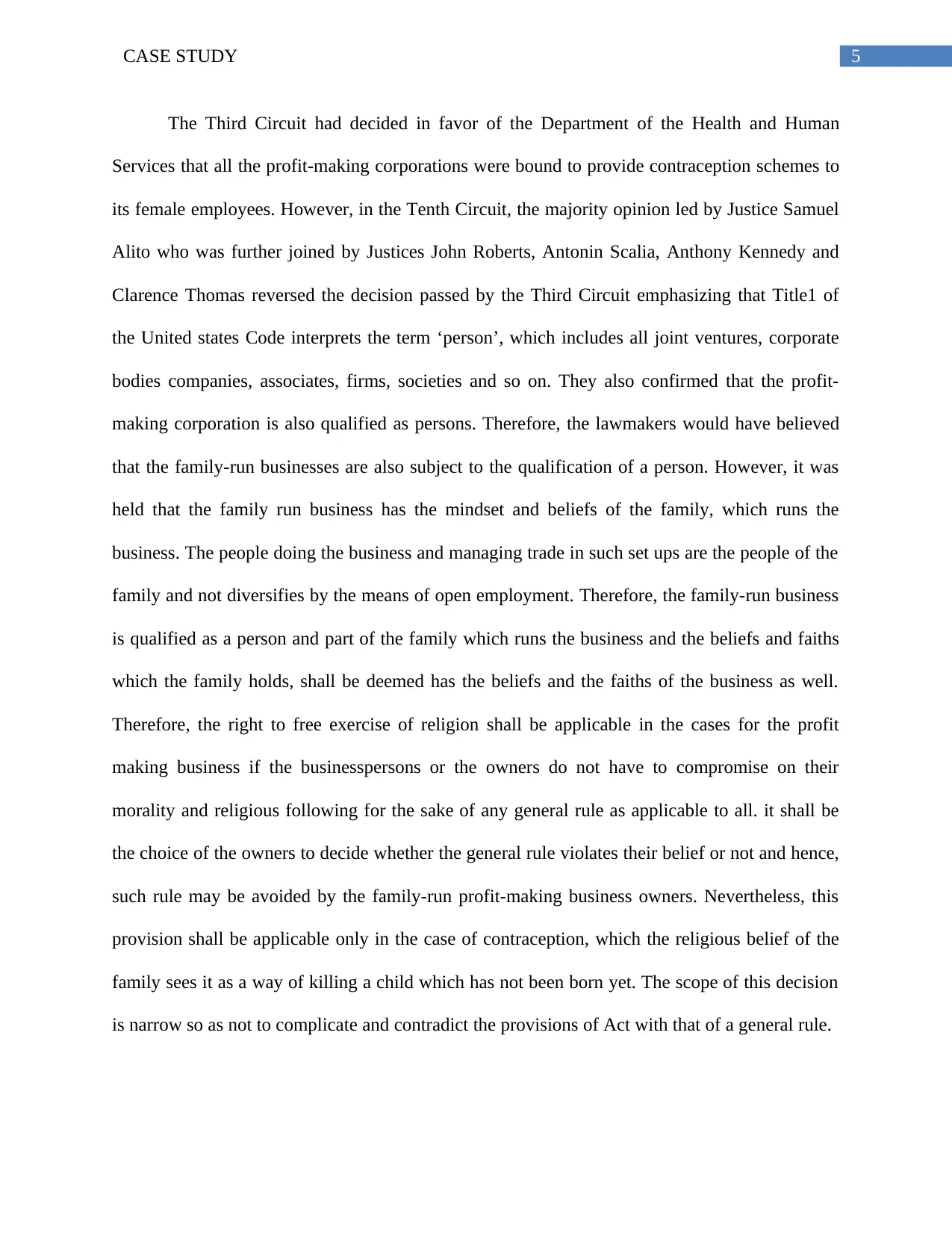
5CASE STUDY
The Third Circuit had decided in favor of the Department of the Health and Human
Services that all the profit-making corporations were bound to provide contraception schemes to
its female employees. However, in the Tenth Circuit, the majority opinion led by Justice Samuel
Alito who was further joined by Justices John Roberts, Antonin Scalia, Anthony Kennedy and
Clarence Thomas reversed the decision passed by the Third Circuit emphasizing that Title1 of
the United states Code interprets the term ‘person’, which includes all joint ventures, corporate
bodies companies, associates, firms, societies and so on. They also confirmed that the profit-
making corporation is also qualified as persons. Therefore, the lawmakers would have believed
that the family-run businesses are also subject to the qualification of a person. However, it was
held that the family run business has the mindset and beliefs of the family, which runs the
business. The people doing the business and managing trade in such set ups are the people of the
family and not diversifies by the means of open employment. Therefore, the family-run business
is qualified as a person and part of the family which runs the business and the beliefs and faiths
which the family holds, shall be deemed has the beliefs and the faiths of the business as well.
Therefore, the right to free exercise of religion shall be applicable in the cases for the profit
making business if the businesspersons or the owners do not have to compromise on their
morality and religious following for the sake of any general rule as applicable to all. it shall be
the choice of the owners to decide whether the general rule violates their belief or not and hence,
such rule may be avoided by the family-run profit-making business owners. Nevertheless, this
provision shall be applicable only in the case of contraception, which the religious belief of the
family sees it as a way of killing a child which has not been born yet. The scope of this decision
is narrow so as not to complicate and contradict the provisions of Act with that of a general rule.
The Third Circuit had decided in favor of the Department of the Health and Human
Services that all the profit-making corporations were bound to provide contraception schemes to
its female employees. However, in the Tenth Circuit, the majority opinion led by Justice Samuel
Alito who was further joined by Justices John Roberts, Antonin Scalia, Anthony Kennedy and
Clarence Thomas reversed the decision passed by the Third Circuit emphasizing that Title1 of
the United states Code interprets the term ‘person’, which includes all joint ventures, corporate
bodies companies, associates, firms, societies and so on. They also confirmed that the profit-
making corporation is also qualified as persons. Therefore, the lawmakers would have believed
that the family-run businesses are also subject to the qualification of a person. However, it was
held that the family run business has the mindset and beliefs of the family, which runs the
business. The people doing the business and managing trade in such set ups are the people of the
family and not diversifies by the means of open employment. Therefore, the family-run business
is qualified as a person and part of the family which runs the business and the beliefs and faiths
which the family holds, shall be deemed has the beliefs and the faiths of the business as well.
Therefore, the right to free exercise of religion shall be applicable in the cases for the profit
making business if the businesspersons or the owners do not have to compromise on their
morality and religious following for the sake of any general rule as applicable to all. it shall be
the choice of the owners to decide whether the general rule violates their belief or not and hence,
such rule may be avoided by the family-run profit-making business owners. Nevertheless, this
provision shall be applicable only in the case of contraception, which the religious belief of the
family sees it as a way of killing a child which has not been born yet. The scope of this decision
is narrow so as not to complicate and contradict the provisions of Act with that of a general rule.
⊘ This is a preview!⊘
Do you want full access?
Subscribe today to unlock all pages.

Trusted by 1+ million students worldwide
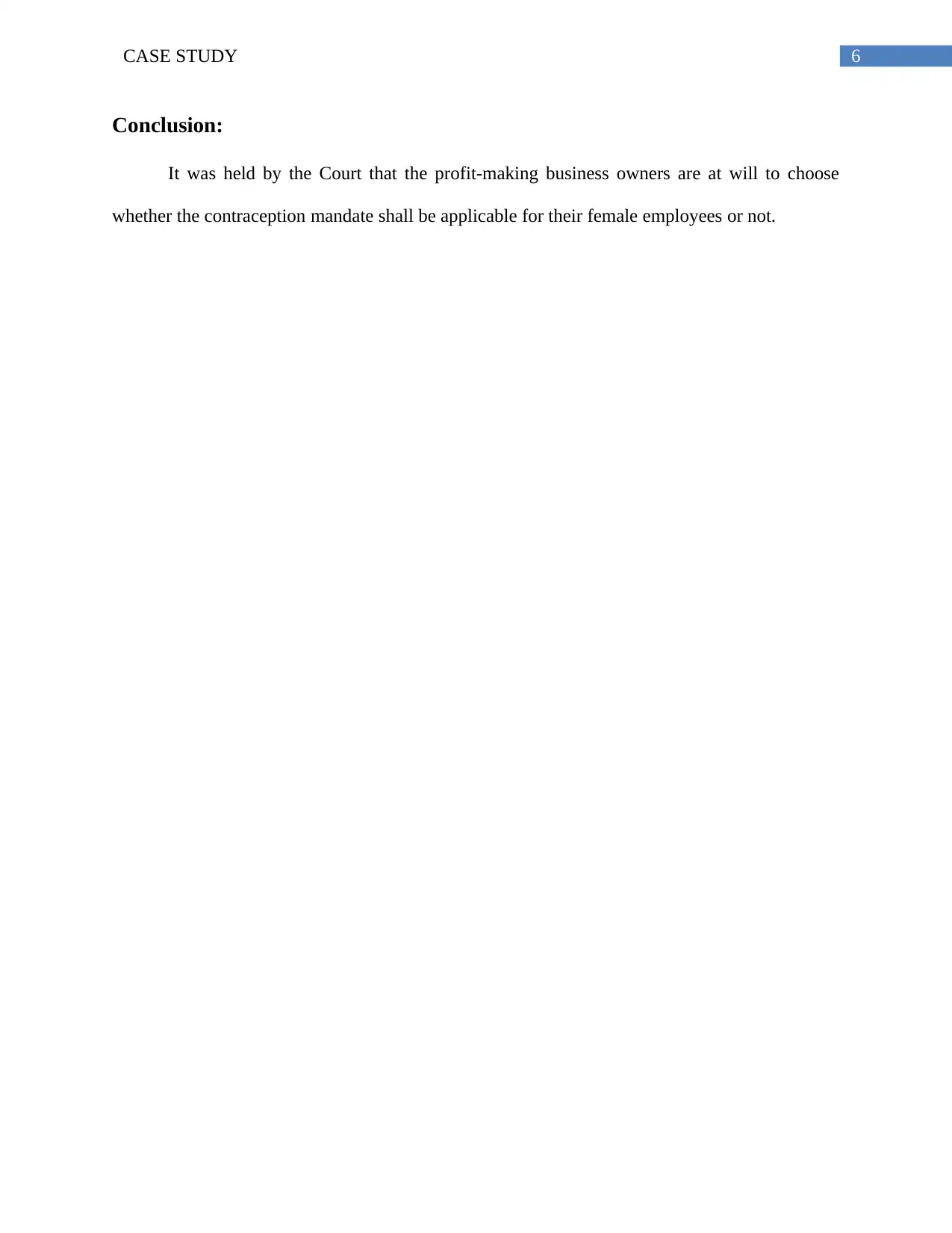
6CASE STUDY
Conclusion:
It was held by the Court that the profit-making business owners are at will to choose
whether the contraception mandate shall be applicable for their female employees or not.
Conclusion:
It was held by the Court that the profit-making business owners are at will to choose
whether the contraception mandate shall be applicable for their female employees or not.
Paraphrase This Document
Need a fresh take? Get an instant paraphrase of this document with our AI Paraphraser
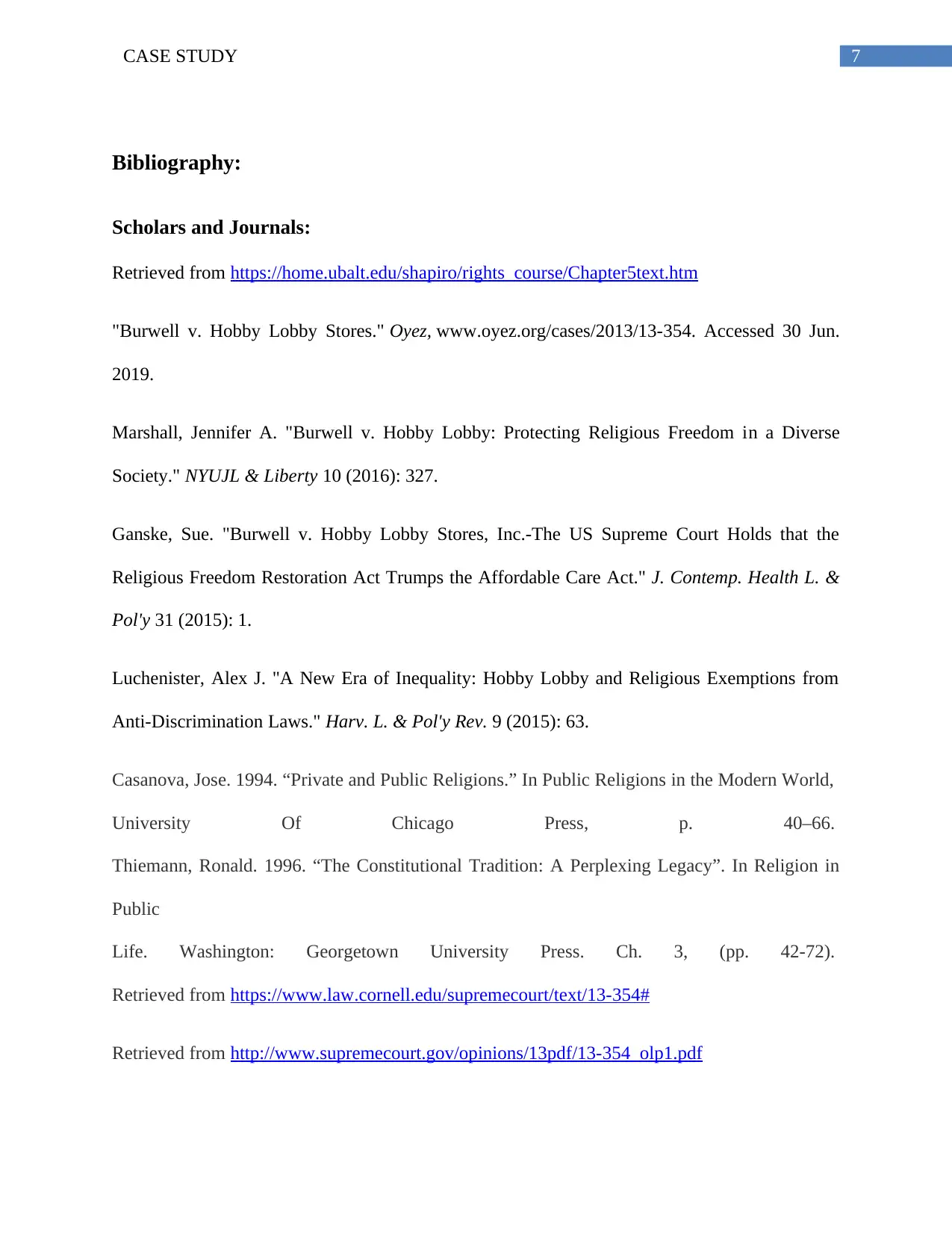
7CASE STUDY
Bibliography:
Scholars and Journals:
Retrieved from https://home.ubalt.edu/shapiro/rights_course/Chapter5text.htm
"Burwell v. Hobby Lobby Stores." Oyez, www.oyez.org/cases/2013/13-354. Accessed 30 Jun.
2019.
Marshall, Jennifer A. "Burwell v. Hobby Lobby: Protecting Religious Freedom in a Diverse
Society." NYUJL & Liberty 10 (2016): 327.
Ganske, Sue. "Burwell v. Hobby Lobby Stores, Inc.-The US Supreme Court Holds that the
Religious Freedom Restoration Act Trumps the Affordable Care Act." J. Contemp. Health L. &
Pol'y 31 (2015): 1.
Luchenister, Alex J. "A New Era of Inequality: Hobby Lobby and Religious Exemptions from
Anti-Discrimination Laws." Harv. L. & Pol'y Rev. 9 (2015): 63.
Casanova, Jose. 1994. “Private and Public Religions.” In Public Religions in the Modern World,
University Of Chicago Press, p. 40–66.
Thiemann, Ronald. 1996. “The Constitutional Tradition: A Perplexing Legacy”. In Religion in
Public
Life. Washington: Georgetown University Press. Ch. 3, (pp. 42-72).
Retrieved from https://www.law.cornell.edu/supremecourt/text/13-354#
Retrieved from http://www.supremecourt.gov/opinions/13pdf/13-354_olp1.pdf
Bibliography:
Scholars and Journals:
Retrieved from https://home.ubalt.edu/shapiro/rights_course/Chapter5text.htm
"Burwell v. Hobby Lobby Stores." Oyez, www.oyez.org/cases/2013/13-354. Accessed 30 Jun.
2019.
Marshall, Jennifer A. "Burwell v. Hobby Lobby: Protecting Religious Freedom in a Diverse
Society." NYUJL & Liberty 10 (2016): 327.
Ganske, Sue. "Burwell v. Hobby Lobby Stores, Inc.-The US Supreme Court Holds that the
Religious Freedom Restoration Act Trumps the Affordable Care Act." J. Contemp. Health L. &
Pol'y 31 (2015): 1.
Luchenister, Alex J. "A New Era of Inequality: Hobby Lobby and Religious Exemptions from
Anti-Discrimination Laws." Harv. L. & Pol'y Rev. 9 (2015): 63.
Casanova, Jose. 1994. “Private and Public Religions.” In Public Religions in the Modern World,
University Of Chicago Press, p. 40–66.
Thiemann, Ronald. 1996. “The Constitutional Tradition: A Perplexing Legacy”. In Religion in
Public
Life. Washington: Georgetown University Press. Ch. 3, (pp. 42-72).
Retrieved from https://www.law.cornell.edu/supremecourt/text/13-354#
Retrieved from http://www.supremecourt.gov/opinions/13pdf/13-354_olp1.pdf
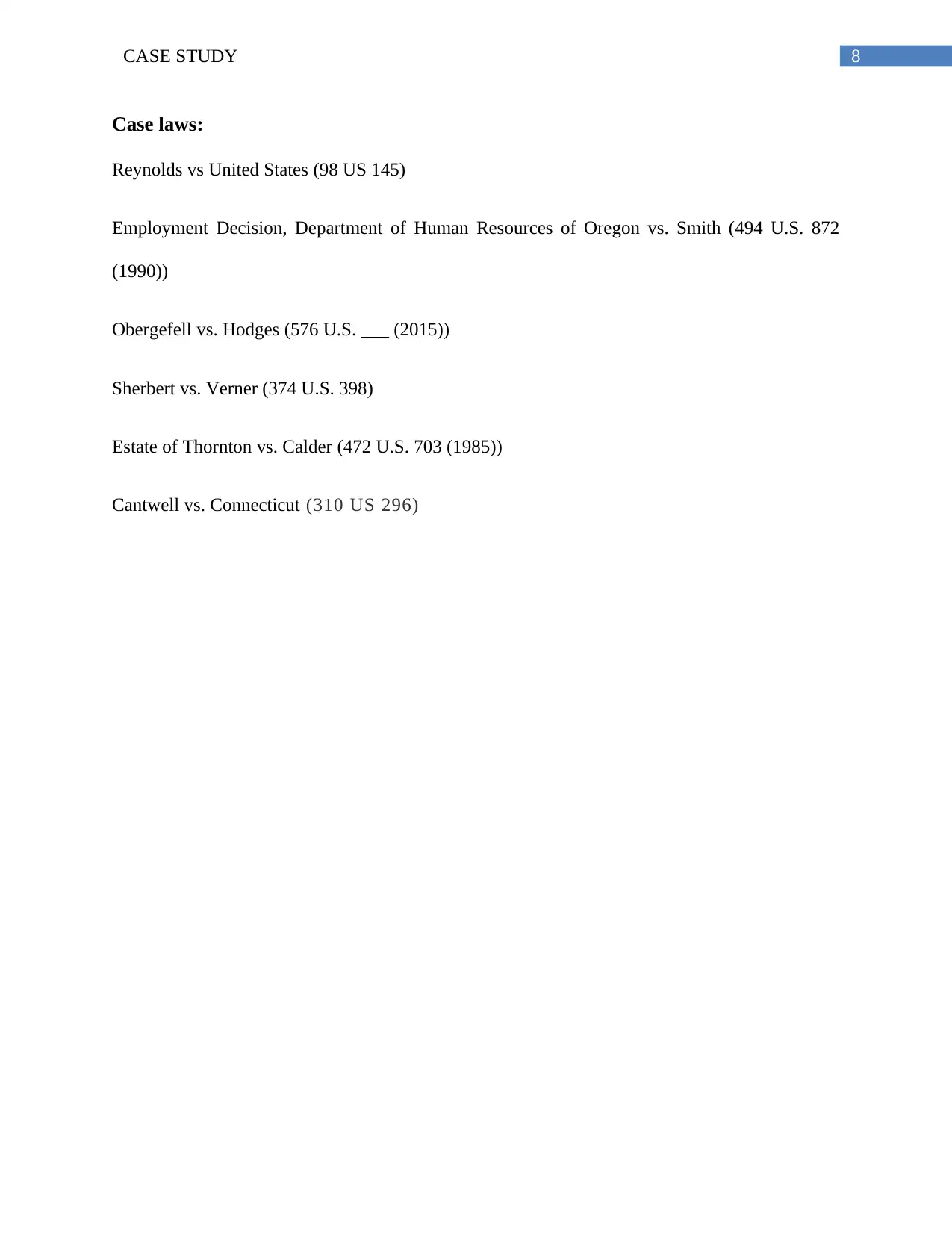
8CASE STUDY
Case laws:
Reynolds vs United States (98 US 145)
Employment Decision, Department of Human Resources of Oregon vs. Smith (494 U.S. 872
(1990))
Obergefell vs. Hodges (576 U.S. ___ (2015))
Sherbert vs. Verner (374 U.S. 398)
Estate of Thornton vs. Calder (472 U.S. 703 (1985))
Cantwell vs. Connecticut (310 US 296)
Case laws:
Reynolds vs United States (98 US 145)
Employment Decision, Department of Human Resources of Oregon vs. Smith (494 U.S. 872
(1990))
Obergefell vs. Hodges (576 U.S. ___ (2015))
Sherbert vs. Verner (374 U.S. 398)
Estate of Thornton vs. Calder (472 U.S. 703 (1985))
Cantwell vs. Connecticut (310 US 296)
⊘ This is a preview!⊘
Do you want full access?
Subscribe today to unlock all pages.

Trusted by 1+ million students worldwide
1 out of 9
Related Documents
Your All-in-One AI-Powered Toolkit for Academic Success.
+13062052269
info@desklib.com
Available 24*7 on WhatsApp / Email
![[object Object]](/_next/static/media/star-bottom.7253800d.svg)
Unlock your academic potential
Copyright © 2020–2025 A2Z Services. All Rights Reserved. Developed and managed by ZUCOL.




